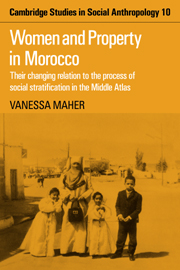 Women and Property in Morocco
Women and Property in Morocco Published online by Cambridge University Press: 27 October 2009
Following the general account of the relation of the population to property and to the market, I present more detailed material on the economic organisation of two ksoury Aghzim and Bentaleb, noting that there are marked social and economic inequalities among ksar residents. Relations between the ksour have been affected by the intrusion of the Makhzen, and with it of institutions related to the market economy – shops, schools. Nevertheless certain areas of social life, such as marriage, are still governed by regional and estate interests.
I go on to discuss the economic organisation and occupational structure of a quarter in Akhdar town, and to contrast the economic and social conditions prevailing in town and ksar respectively.
The valley and the ‘ksour’
The stream which sustains the ksour runs northwards from the mountains. In the spring, it collects the melting snow, often flooding its banks and ruining riverside fields. It is harnessed to run water-mills – several operate in each riverside ksar. In the summer it is channelled off to irrigate lucerne fields, and in the autumn the wheatfields before the ploughing begins.
Aghzim and Bentaleb, my host ksour, are built on a rocky hill which drops steeply on three sides, leaving the fourth one to slope more gradually towards the north. Bentaleb on the east side of the hill commands the river running at its base.
To save this book to your Kindle, first ensure [email protected] is added to your Approved Personal Document E-mail List under your Personal Document Settings on the Manage Your Content and Devices page of your Amazon account. Then enter the ‘name’ part of your Kindle email address below. Find out more about saving to your Kindle.
Note you can select to save to either the @free.kindle.com or @kindle.com variations. ‘@free.kindle.com’ emails are free but can only be saved to your device when it is connected to wi-fi. ‘@kindle.com’ emails can be delivered even when you are not connected to wi-fi, but note that service fees apply.
Find out more about the Kindle Personal Document Service.
To save content items to your account, please confirm that you agree to abide by our usage policies. If this is the first time you use this feature, you will be asked to authorise Cambridge Core to connect with your account. Find out more about saving content to Dropbox.
To save content items to your account, please confirm that you agree to abide by our usage policies. If this is the first time you use this feature, you will be asked to authorise Cambridge Core to connect with your account. Find out more about saving content to Google Drive.